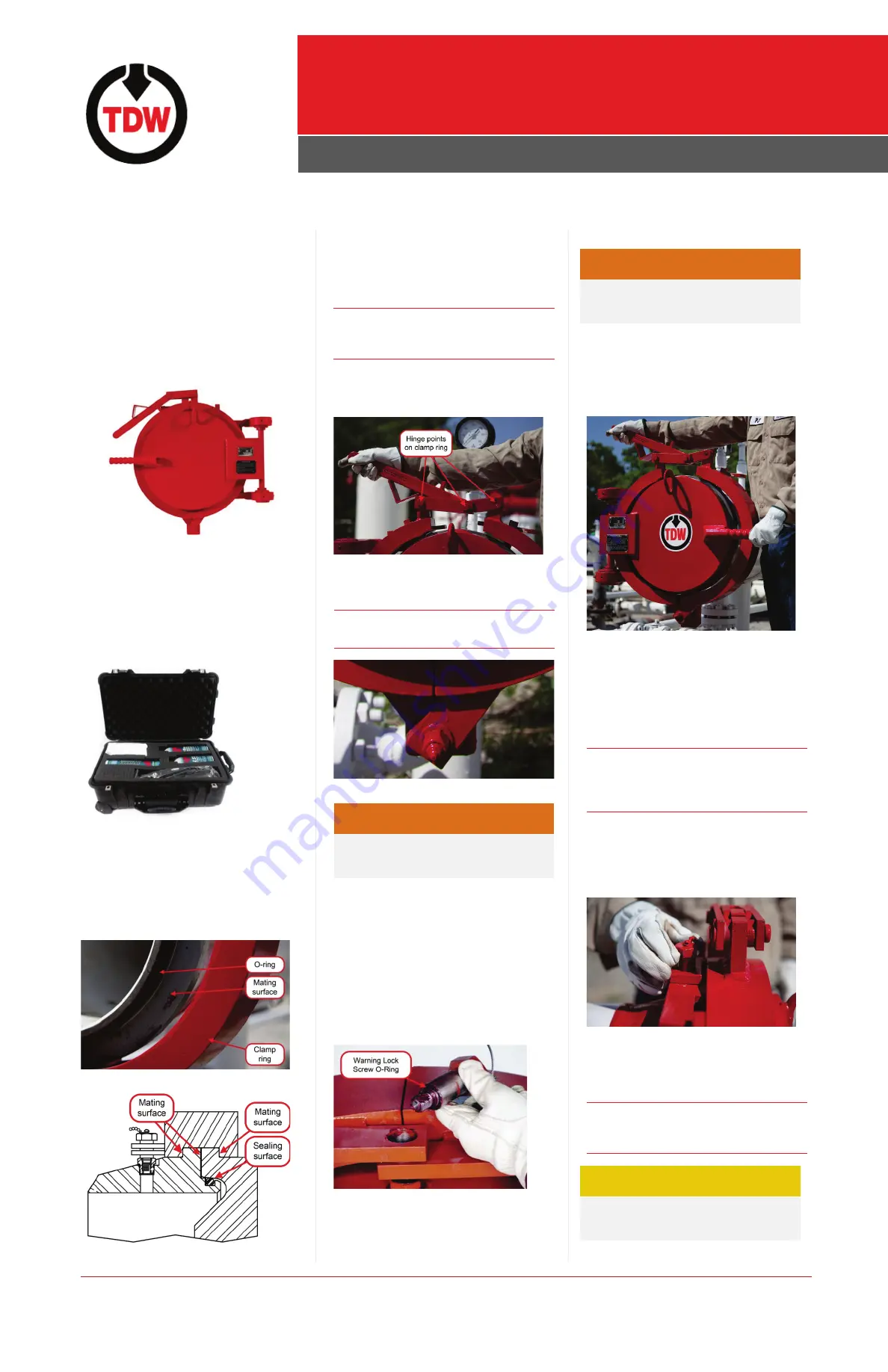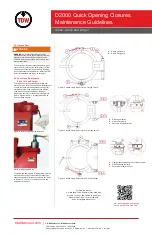
D2000 Quick Opening Closures
Maintenance Guidelines
Sizes: 4-inch and Larger
tdwilliamson.com |
T.D. Williamson, Inc. is ISO 9001 Certified.
TDW Pub. No. 00-3795-0610 | DAP00083
© Copyright 2015 All rights reserved. T.D. Williamson, Inc. | Printed in the U.S.A. | July 2015
Reference the Operation and User Manual for
complete installation, maintenance, and operation
instruction.
T.D. Williamson (TDW) Clamp Ring Closures are
quick-opening closures, easily operated by one person.
A closure may not operate effectively if it has been
subjected to misuse, external damage, or has been
operated or maintained contrary to TDW’s operations
and user manual. It is mandatory that correct
procedures are followed during the use of TDW
closures to maintain their safety features, efficiency,
and ease of operation.
Figure 1. D2000 Quick Opening Closure
A maintenance kit is available for purchase which
includes grease, penetrant spray, and other tools to
assist in maintenance of the O-rings, clamp ring, and
pressure warning lock. Please contact a TDW sales
representative for pricing information. Listed below are
the maintenance kit part numbers:
4- through 12-inch: 00-9560-0100-00
16- through 30-inch: 00-9560-0200-00
32-inch and larger: 00-9560-0300-00
Figure 2. Maintenance Kit
1.0 General Maintenance Guidelines
The following reminders are essential in ensuring that
the TDW Quick Opening Closure operates properly:
A. Clean the O-rings, sealing surfaces, and mating
surfaces. Coat them with a thin film of grease
before the closure is closed (Figures 3 and 4).
Figure 3. Closure O-ring, Mating Surface, and Clamp
Ring
Figure 4. Mating and Sealing Surfaces
B. Inspect the O-ring for cuts, scratches,
deterioration, twisting, or swelling. Replace O-
rings if there are signs of abnormalities.
C. Clean the interior surfaces of the clamp ring, and
apply a thin film of lubricant before the closure is
closed.
D. Lubricate all hinge points at regular intervals
(Figure 5). ThermaPlex
®
aqua bearing grease is
provided with the maintenance kit however there
are various types of grease that may be used.
Figure 5. Clamp Ring Hinge Points
E. Grease the clamp ring pivot pin located at the
bottom of the clamp. (Figure 6).
Figure 6. Clamp Ring Pivot Pin
⚠
WARNING
WARNING:
Ensure that the door, clamp ring, and
pressure warning lock are fully closed and secured
before attempting to pressurize the vessel.
2.0 O-Rings
There are two O-rings on the D2000 Quick Opening
Closure. The large, cross-sectional diameter O-ring
located on the periphery of the closure’s barrel collar
provides positive sealing and is protected from damage
by tools, pigs, or debris (refer to Figure 3). The second
O-ring–on the pressure warning lock screw–seals the
pressure warning lock in the bushing (Figure 7).
Consider O-ring material compatibility with pipeline
product; certain chemicals may cause the O-rings to
swell. Swollen O-rings may prevent the clamps from
engaging and properly closing the door. Consult TDW
for proper O-ring selection.
Figure 7. Warning Lock Screw O-Ring
Always clean and coat the O-rings with a thin film of
grease each time the closure is open. Inspect for cuts,
scratches, and deterioration. Replace O-rings if there is
any sign of damage.
3.0 Clamp Ring
⚠
WARNING
WARNING:
Never force the clamp ring operating
mechanism if the clamp ring does not operate
freely.
The clamp ring (Figure 8) should always operate freely.
Do NOT force the clamp ring operating mechanism or
use a “cheater” pipe on the handle of a lever-operated
clamp ring. Damage to components may result.
Damaged components could prevent the clamp ring
from closing fully.
Figure 8. Clamp Ring Opening
If excessive force has been applied on the clamp ring
operating mechanism, the component attachment
welds should be visually inspected for damage and/or
examined by any common NDT method. Should any
questions or difficulties arise at the time in the use of
the TDW clamp ring closures, please contact TDW
immediately.
4.0 Pressure Warning Lock
The closure contains a pressure warning lock as shown
in Figure 8. In accordance with ASME code, this lock
alerts the operator to pressure in the vessel before the
closure is opened.
Figure 9. Pressure Warning Lock
Ensure the threads are clean and free of defects.
Inspect the O-ring and bushing. Keep the assembly
free of paint. Also, lube the bushing threads
periodically.
⚠
CAUTION
CAUTION
: Do not overtighten the pressure warning
lock. Doing so may damage the threads and will
make it difficult to remove.
NOTE
: Apply only a thin film of lubricant/grease to
closure components. Over-greasing may prevent the
clamps from engaging and properly closing the door.
NOTE
: The clamp ring pivot pin should be lubricated at
all points along the pin; not just the front of the pin.
NOTE
: Certain pipeline products, such as heavy crude,
may contain excess debris or paraffin. Thoroughly
clean the clamp ring of any excess byproduct to
ensure it closes fully.
NOTE
: Ensure that the pressure warning lock is
secured to the closure via a cable or chain to avoid
misplacement during operation.




















